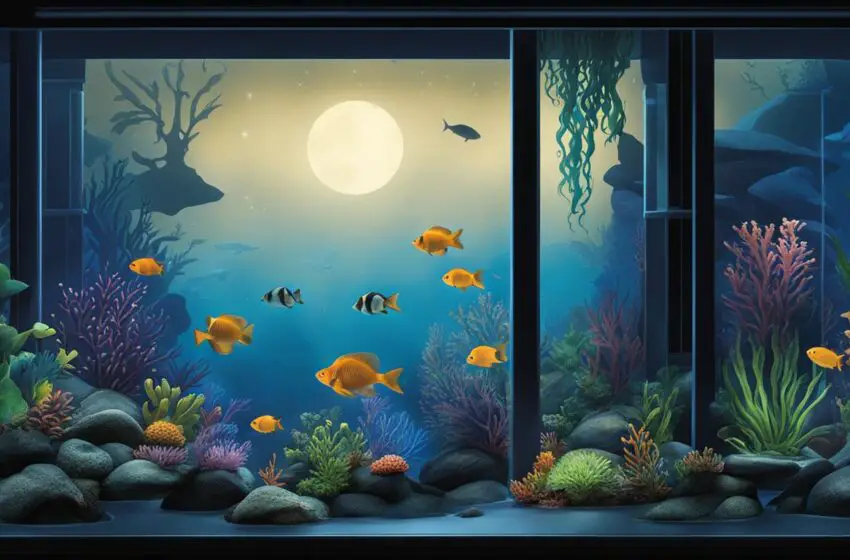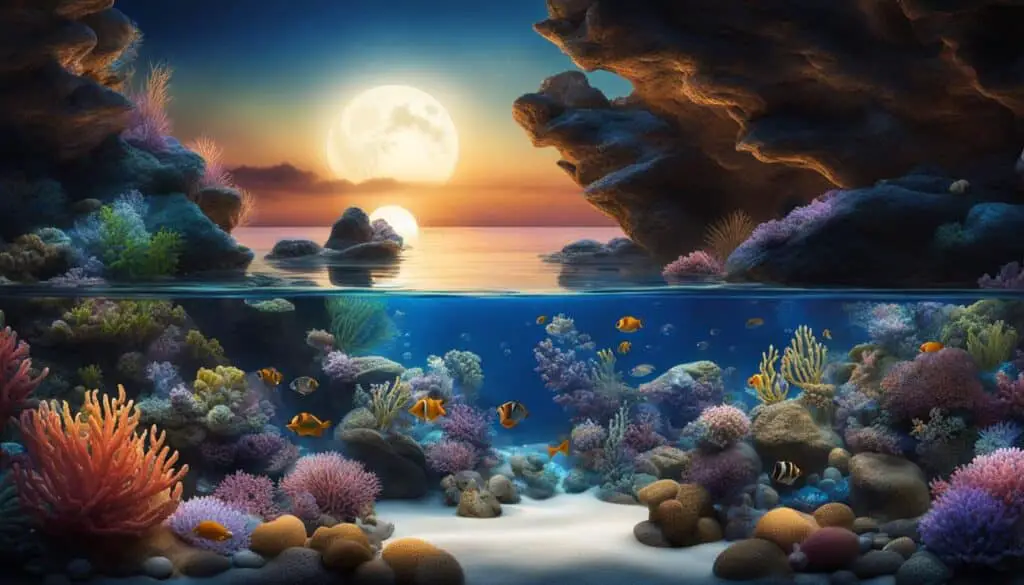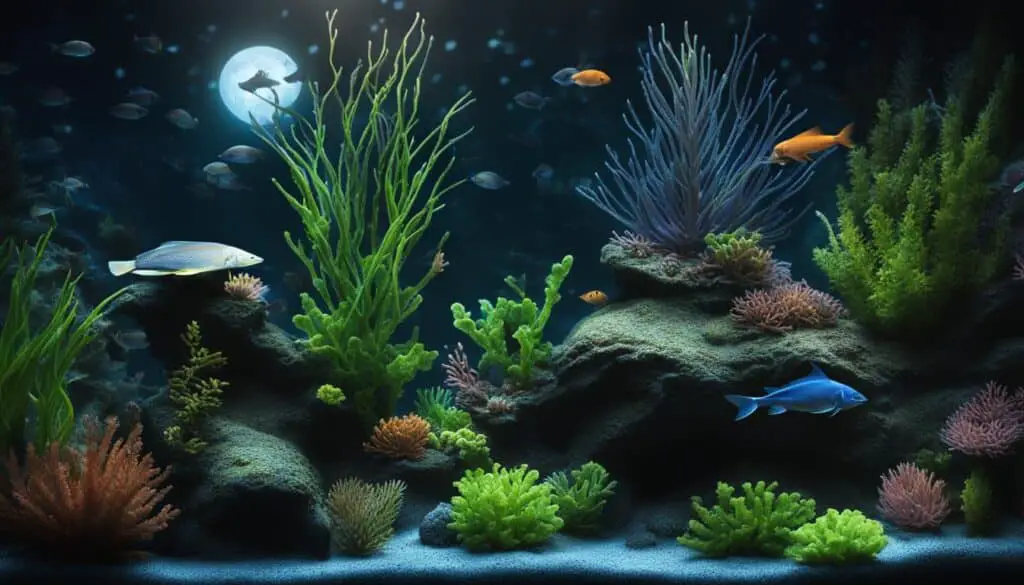Exploring Moonlighting for Nocturnal Marine Creatures

Welcome to our comprehensive guide on saltwater aquarium lighting. In this article, we will delve into the fascinating world of moonlighting and its benefits for nocturnal marine creatures. Moonlighting in aquariums aims to mimic the natural light cycle found in the ocean, providing a range of advantages for the health and well-being of your saltwater tank’s inhabitants.
The concept of moonlighting involves using specialized lights during nighttime to simulate moonlight and create a soothing and visually appealing environment for your marine life. By incorporating moonlighting into your aquarium setup, you can provide a more natural habitat for your nocturnal tank mates.
Different colors of moonlights, such as blue, red, and white, have different effects on coral, fish, and invertebrates. Each color offers unique benefits and considerations, allowing aquarists to customize their lighting setup based on the species they house.
Key Takeaways:
- Saltwater aquarium moonlighting replicates natural light cycles found in the ocean.
- Different colored moonlights have varying effects on coral, fish, and invertebrates.
- Blue moonlighting provides aesthetic appeal and enhances the fluorescence of certain corals.
- Red moonlighting stimulates nocturnal activity in fish and invertebrates.
- White moonlighting promotes natural behavior, encourages coral reproduction, and benefits overall tank health.
Benefits of Blue Moonlighting in Saltwater Aquariums
Blue moonlighting in saltwater aquariums is a popular choice among aquarists due to its visually appealing and calming effect. While the benefits to marine life may be relatively minimal, the aesthetic advantages make it a popular lighting option for many aquarium enthusiasts.
The soothing blue hue of moonlighting creates a serene and relaxing ambiance in the tank, replicating the peacefulness of moonlit nights in the ocean. This subtle lighting can help reduce stress levels in marine creatures, promoting a healthier and more natural environment.
Additionally, blue moonlighting has the potential to enhance the fluorescence of certain corals. Some coral species possess fluorescent pigments that can be activated under blue light, producing a stunning visual display. This phenomenon adds a captivating and ethereal beauty to the aquarium, making it a delightful sight for both the aquarist and viewers.
However, it is important to note that the primary benefits of blue moonlighting are aesthetic rather than biological. While it provides a visually pleasing atmosphere and enhances the vibrancy of corals, it does not significantly impact the behavior or well-being of marine life in the aquarium. Therefore, aquarists should consider blue moonlighting primarily for its visual appeal rather than its direct effects on marine organisms.
Red Moonlighting for Nocturnal Activity
When it comes to creating a natural and captivating environment for nocturnal marine creatures in saltwater aquariums, red moonlighting can be a fascinating option to consider. This type of lighting is believed to promote nocturnal activity in fish and invertebrates, enhancing their natural behaviors and encouraging them to come out of hiding after dark.
In particular, red moonlighting can be beneficial for certain invertebrates that prefer a more active lifestyle at night. It can coax them into displaying their natural behaviors, creating a more dynamic and engaging aquarium experience. Additionally, red lighting can also entice fish that are typically hesitant to venture out during nighttime hours.
While the effects of red moonlighting on saltwater fish are less documented compared to freshwater fish, some studies suggest that red lighting may have positive effects on freshwater fish growth. However, more research is needed to understand its precise impact on saltwater fish species.
Although red moonlighting may not be as commonly used as blue or white moonlighting in saltwater aquariums, it offers a unique opportunity to mimic the nocturnal environment and stimulate the natural behaviors of marine life.
The Benefits of Red Moonlighting:
- Promotes nocturnal activity in fish and invertebrates
- Encourages the display of natural behaviors
- Coaxes out fish that are hesitant to venture out at night
- May have positive effects on freshwater fish growth (further research needed for saltwater fish)
Incorporating red moonlighting into your saltwater aquarium can add an intriguing dimension to your tank and provide a closer representation of the natural environment for your nocturnal marine creatures.
Comparison of Different Moonlighting Options
| Moonlighting Option | Benefits | Effects on Marine Life |
|---|---|---|
| Blue Moonlighting | Visually appealing | Enhances fluorescence of certain corals |
| Red Moonlighting | Stimulates nocturnal activity | Promotes natural behaviors in fish and invertebrates |
| White Moonlighting | Promotes natural behavior and activity patterns | Increases spawning and reproduction in coral |
Source: First source.
The Advantages of White Moonlighting in Saltwater Aquariums
White moonlighting is highly beneficial for saltwater aquariums due to its ability to closely mimic natural moonlight. It provides a range of advantages for both the marine life and the overall health of the tank.
“White moonlighting not only enhances the visual appeal of the aquarium but also promotes natural behavior and activity patterns in its inhabitants,” says Dr. Marine Biologist from Oceanic Research Institute. “Furthermore, white lighting has a significant impact on coral reproduction and regeneration.”
One of the key benefits of white moonlighting is its impact on coral reproduction. When exposed to white lighting, corals often experience a surge in spawning activity. The increased availability of microorganisms that corals feed on, along with the brighter light cycle, creates an environment that supports their reproductive processes. This allows for the successful growth and regeneration of coral colonies.
Moreover, white moonlighting encourages natural behavior in tank mates by providing them with a lighting environment that closely resembles their natural habitat. This promotes their overall well-being and minimizes stress levels, leading to healthier and more active marine life.
In addition to its biological advantages, white moonlighting offers an aesthetically pleasing appearance to the aquarium, enhancing its visual appeal for viewers. The subtle glow of white lighting creates a serene and tranquil atmosphere, adding to the overall beauty of the tank.
Implementing white moonlighting as part of a balanced light cycle, with 12 hours of regular lights and 12 hours of moonlighting, is highly recommended for saltwater aquariums. This provides the necessary periods of darkness for marine creatures to rest and maintains a natural day-night cycle.
To summarize, white moonlighting in saltwater aquariums offers a range of benefits, including promoting natural behavior, enhancing coral reproduction, and contributing to the overall health and appearance of the tank. It is a crucial element to consider for aquarists aiming to maintain a thriving and visually appealing aquarium. So, be sure to incorporate white moonlighting in your saltwater aquarium for optimal results!

Light Cycles and Overall Tank Health
Light cycles are of utmost importance when it comes to maintaining the overall health of a saltwater aquarium. A balanced approach that incorporates both regular lights and moonlighting has proven to yield the best results. By following a 12-hour cycle of regular lights followed by 12 hours of moonlighting, a natural day-night rhythm is established, providing marine creatures with the necessary periods of darkness for rest. This balanced light cycle also plays a significant role in regulating the photosynthetic activity of coral and promoting the growth of beneficial microorganisms within the tank.
Consistency in light cycles is a key factor in ensuring the well-being of tank mates and the success of coral reproduction. Just as in nature, where the moonlight serves as a guide for various biological processes, mimicking these light cycles in an aquarium setting helps replicate the natural environment and support marine life’s health and vitality.
| Benefits of Balanced Light Cycles for Tank Health | Effects of Light Cycles on Marine Life |
|---|---|
|
|

“Implementing balanced light cycles not only replicates nature but also supports the well-being of the marine life in your saltwater aquarium. By providing periods of rest and promoting natural behavior, this approach creates an optimal environment for the growth, reproduction, and overall health of your tank’s inhabitants.”
Conclusion
When it comes to lighting a saltwater aquarium, moonlighting techniques offer a way to create a more natural and visually appealing environment for marine life. Blue moonlighting provides aesthetic benefits, while red moonlighting stimulates nocturnal activity. However, white moonlighting is considered the optimal choice for saltwater aquarium lighting, promoting natural behavior, enhancing coral reproduction, and benefiting the overall health of the tank.
Implementing balanced light cycles, with 12 hours of regular lights and 12 hours of moonlighting, is crucial for creating an optimal environment that supports the well-being of all tank inhabitants. This approach allows for a natural day-night cycle and provides the necessary periods of darkness for marine creatures to rest. It also regulates the photosynthetic activity of coral and promotes the growth of beneficial microorganisms.
By understanding the specific effects of different colored moonlights, aquarists can tailor their lighting techniques to meet the needs of nocturnal marine creatures in their saltwater aquariums. By prioritizing white moonlighting and maintaining balanced light cycles, aquarists can create an environment that promotes natural behavior, enhances coral reproduction, and ensures the overall health and well-being of their saltwater tank. With this saltwater aquarium lighting guide, aquarists can achieve optimal lighting for their marine life and create a captivating underwater world.
FAQ
What is the benefit of moonlighting in saltwater aquariums?
Moonlighting in saltwater aquariums provides a natural light cycle and a “cool down” period for marine creatures, similar to their natural habitat in the ocean. It promotes natural behavior and encourages spawning and reproduction in coral.
What are the different colored moonlights used in saltwater aquariums?
The different colored moonlights used in saltwater aquariums include blue, red, and white. Each color has varying effects on coral, fish, and invertebrates.
What is the benefit of blue moonlighting in saltwater aquariums?
Blue moonlighting in saltwater aquariums is aesthetically appealing and can enhance the fluorescence of certain corals. However, its primary benefit is more of an aesthetic one rather than a biological one.
Does red moonlighting promote nocturnal activity in fish and invertebrates?
Yes, red moonlighting is believed to promote nocturnal activity in fish and invertebrates. It can encourage certain invertebrates to be more active at night and coax out fish that are typically hesitant to venture out after dark.
What is the most appropriate type of moonlighting for saltwater aquariums?
White moonlighting is considered the most appropriate type of lighting for saltwater aquariums as it closely mimics natural moonlight. It promotes natural behavior, enhances coral reproduction, and benefits the overall health of the tank.
What is the recommended light cycle for saltwater aquariums?
A balanced light cycle with 12 hours of regular lights and 12 hours of moonlighting has shown the best results for the overall health of the tank. This allows for a natural day-night cycle and provides the necessary periods of darkness for marine creatures to rest and for coral to regulate photosynthetic activity.
Source Links
- https://www.carolinafishtalk.com/threads/moonlight-red-white-or-blue.25786/
- https://escience.washington.edu/blog-moonlighting-in-oceanography-our-work-with-the-regional-cabled-array/
- https://www.ecomagazine.com/news/coastal/megacities-out-shine-the-moon-in-coastal-environments-according-to-the-first-quantification-of-artificial-light-at-night



